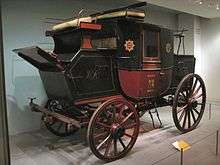Winterbottom v Wright
Winterbottom v Wright (1842) 10 M&W 109[1] was an important case in English common law responsible for constraining the law's stance on negligence in the 19th century.
| Winterbottom v Wright | |
|---|---|
 | |
| Court | Exchequer of pleas |
| Full case name | Winterbottom v. Wright |
| Decided | 6 June 1846 |
| Citation(s) | (1842) 10 M&W 109; (1842) 152 ER 402 |
| Case history | |
| Subsequent action(s) | none |
| Case opinions | |
| Abinger, Alderson and Rolfe BB gave judgments against the plaintiff, Gurney B concurring | |
| Court membership | |
| Judge(s) sitting | Lord Abinger, Lord Chief Baron of the Exchequer Baron Rolfe |
Facts
The plaintiff Winterbottom had been contracted by the Postmaster-General to drive a mail coach supplied by the Postmaster. The defendant Wright had been contracted by the Postmaster to maintain the coach in a safe state. The coach collapsed while Winterbottom was driving and he was injured. He claimed that Wright had "negligently conducted himself, and so utterly disregarded his aforesaid contract and so wholly and negligently failed to perform his duty in this behalf."[2]
In Winterbottom v. Wright, the court held that the plaintiff had no redress. The principle of Winterbottom meant that consumers who were injured by defective products in the 19th century had no legal action against the defective execution of a contract to which they were not expressly privy.
Judgment
In 1842, the law’s only recognition of "negligence" was in respect of a breach of contract. As the plaintiff was not in a contract with the defendant the court ruled in favour of the defendant on the basis of the doctrine of privity of contract.[2]
Winterbottom sought to extend the ratio of the court in Langridge v Levy[3] but the court rejected this on the grounds that that case involved a gun whose safety had been misrepresented by the vendor.[2]
The case was also possibly influenced by public policy. If the plaintiff were able to sue “there would be unlimited actions” and the public utility of the Postmaster-General was such that allowing such actions would be undesirable for society.[2]
Significance
Though Master of the Rolls William Brett sought to establish a general principle of duty of care in Heaven v. Pender (1883), his judgment was at variance with the majority of the court. The privity argument was subsequently rejected in common law in the U.S. in MacPherson v. Buick Motor Co. (1916) and finally in England by the doctrine of the "neighbour principle" in Donoghue v. Stevenson (1932). This evolution is explained in the article on common law.
Notes
- (1842) 152 ER 402.
- Lunney & Oliphant (2003) pp. 91-92.
- Langridge v Levy (1837) 2 M&W 519; (1837) 150 ER 863.
References
- [Anon.] (1936). "Torts. Liability of negligent manufacturer to remote vendee. The Rule of Winterbottom v. Wright". University of Chicago Law Review. 3 (4): 673–674. doi:10.2307/1596713. JSTOR 1596713.
- Lunney, M. & Oliphant, K. (2003). Tort Law:Text and Materials (2nd ed.). Oxford: Oxford University Press. pp. 91–91. ISBN 0-19-926055-9.
- Palmer, V. (1983). "Why privity entered tort - an historical reexamination of Winterbottom v. Wright". American Journal of Legal History. 27 (1): 85–98. doi:10.2307/844914. JSTOR 844914.
External links
- "Transcript of report". Lawrence University. Retrieved 2007-11-19.